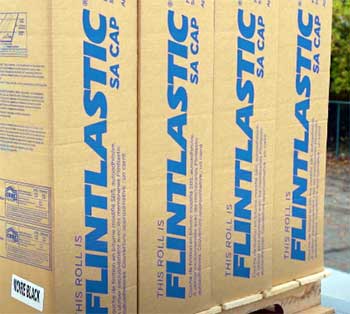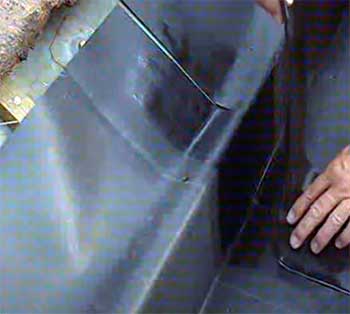You’re probably here because you’re considering Flintlastic roofing for your home or commercial property, right? We’re here to help you make an informed decision.
In this comprehensive review, we’ll take an in-depth look at Flintlastic roofing, weighing up the pros and cons, answering some frequently asked questions, and ultimately helping you decide if this roofing option is right for you.
What is Flintlastic Roofing?
Let’s kick things off by answering the big question – what is Flintlastic roofing? Essentially, Flintlastic is a type of modified bitumen roofing. Known for its durability and versatility, it’s a popular choice for low-slope and flat roofs.
Flintlastic roofing comes in two types: SA (self-adhering) and NA (nailed down and coated). The SA type is sometimes referred to as “peel and stick.” It’s waterproof, durable, and easy to install, making it a common choice for both DIY homeowners and professional roofers.
The Pros of Flintlastic Roofing

One of the biggest advantages of Flintlastic roofing is its durability.
These roofs are designed to withstand harsh weather conditions, including heavy rains, strong winds, and snow.
They also offer excellent UV resistance, reducing the risk of degradation from sun exposure.
Secondly, Flintlastic roofing is relatively easy to install. With the SA type, you just peel and stick, literally.
This ease of installation can potentially save on labor costs, making Flintlastic an affordable choice.
Finally, the versatility of Flintlastic roofing is another significant benefit. Available in various colors and styles, it can be tailored to match the aesthetic of almost any property.
Also Read: Is LeafProof Gutter Guard Worth It?
The Cons of Flintlastic Roofing
Now, let’s talk about the cons. One of the biggest downsides of Flintlastic roofing is its lifespan. While it’s highly durable, it’s not as long-lasting as some other roofing options.
Another con is the temperature sensitivity of Flintlastic roofing. Installation needs to be carried out at the right temperature, usually above 45°F. If it’s too cold, the self-adhesive won’t stick properly, which can lead to problems down the line.
Lastly, Flintlastic roofing is not suitable for all roof types. If you have a steeply pitched roof, this might not be the best option for you.
But if you still love it, here is a nice installation video for you.
Flintlastic Roofing Versus its Competitors
To better understand the worthiness of Flintlastic roofing, let’s pit it against some of its main competitors. In the realm of low-slope and flat roofing systems, the closest competitors would be PVC, EPDM, and TPO roofing.
Each of these systems has its unique strengths and drawbacks, so let’s dive in and compare them to Flintlastic roofing.
- Flintlastic Roofing Vs. PVC Roofing
PVC (polyvinyl chloride) roofing is renowned for its durability and longevity, with a typical lifespan of up to 30 years. It’s highly resistant to fire, chemicals, and water – attributes that Flintlastic also boasts. However, PVC tends to be more expensive due to its superior lifespan and strength. So, while Flintlastic may not last as long, it could be a more budget-friendly option.
- Flintlastic Roofing Vs. EPDM Roofing

EPDM (ethylene propylene diene monomer) roofing, also known as rubber roofing, is another popular choice.
It’s extremely durable and offers excellent resistance to harsh weather conditions, much like Flintlastic.
However, EPDM usually comes in darker shades, which can lead to higher cooling costs in hot climates due to the absorption of heat.
On the other hand, Flintlastic comes in a range of colors, providing more flexibility for homeowners.
- Flintlastic Roofing Vs. TPO Roofing
TPO (thermoplastic olefin) roofing is a newer entrant to the market. It shares many advantages with Flintlastic, such as durability, weather resistance, and ease of installation. Plus, TPO is known for its energy efficiency due to its reflective white surface that helps keep buildings cool.
However, as a newer product, its long-term performance is still under scrutiny. Flintlastic, with its proven track record, could be considered a safer bet.
Also Read: Titan Shingles Pros And Cons.
FAQ: Your Flintlastic Roofing Questions Answered
Typically, a Flintlastic roof can last between 10 to 20 years, depending on factors like the quality of installation and maintenance, weather conditions, and more.
As we’ve already discussed, Flintlastic roofing is a type of modified bitumen roofing system. It’s particularly popular for flat and low-sloping roofs due to its durability, ease of installation, and versatility.
The lifespan of a peel and stick roof, like Flintlastic SA, can be comparable to that of the traditional Flintlastic roofing. Again, expect between 10 to 20 years, although this can vary based on several factors.
One of the longest-lasting materials for flat roofs is PVC (polyvinyl chloride). With proper installation and maintenance, a PVC roof can last up to 30 years.
Wrapping Up
In conclusion, Flintlastic roofing offers many benefits, such as durability, ease of installation, and versatility. However, it also has its downsides, like its shorter lifespan compared to other roofing types and temperature sensitivity during installation.
Ultimately, the choice will depend on your specific needs and circumstances. If you have a low-slope or flat roof, want a durable and versatile option, and live in a moderate climate, Flintlastic could be a great choice for you.
If longevity is your top priority, or you live in a colder climate, it may be worth exploring other options. As always, it’s recommended to consult with a professional roofer before making your decision.
Remember, a roof is more than just a cover for your property – it’s an investment. Choose wisely!



